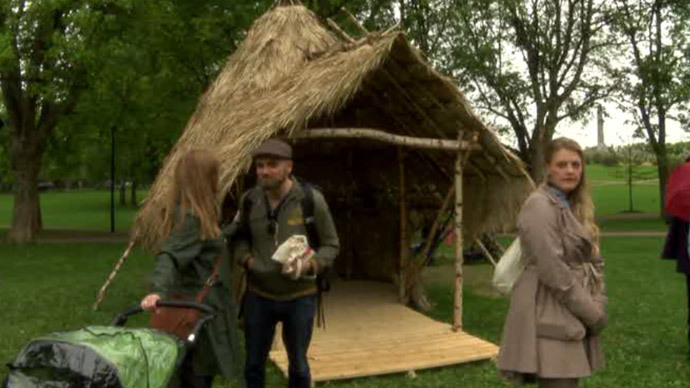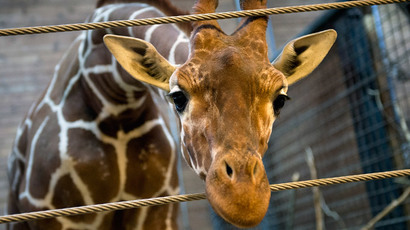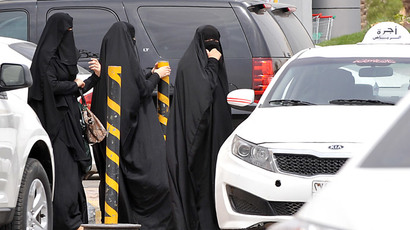‘Human zoo’ project in Norway sparks racism row

A Norwegian project displaying people for entertainment by highlighting the evolution of racism has recreated a notorious ‘human zoo’, depicting Africans in cages as uncivilized and primitive animals, a move that sparked public outrage.
The outdoor exhibition called European Attraction Limited which was set up in the capital, Oslo, in Frogner Park, has recreated a notorious 1914 Norwegian human zoo. The original Congo village, or Kongolandsbyen, was inhabited by about 80 people, actually Senegalese, who were put on display for public entertainment for five months.
That show attracted about 1.4 million people who were eager to watch "traditionally-dressed Africans," living in palm-roof cabins and going about their daily routine of cooking, eating and making handicrafts.
Now, a hundred years later, the curators of the exhibition - Mohamed Ali Fadlabi, who arrived in the country as a Sudanese refugee and Lars Cuzner, a Swedish national - have recreated the notorious display and dedicated it to the 200th anniversary of the Norwegian Constitution.
Liten enebolig på Frogner. Oppussingsobjekt. #kongolandsbyenpic.twitter.com/4EDEuDQJFh
— Eli Frisvold (@FrisEli) May 14, 2014
“We are rebuilding the village in order to address issues around historical amnesia, misrepresentations, the evolution of racism and the architecture behind the nation-building process,” Fadlabi and Cuzner said at the opening.
In order to invite the participants of the show, the artists decided to send out an international request so that anyone from all parts of the world could take part in the reproduction of the exhibition.
A Norwegian woman Nanna Melland who volunteered to be a resident of the village, says she decided to take part in the show as wanted to know what it would be to live in “primitive” huts. However, she is still uncertain about the practical aspects of living in such a village which will stay open till August.
Jeg besøkte Kongolandsbyen igår mens de siste forberedelser pågikk. Ingen satt på utstilling. #dax18pic.twitter.com/YzS6YVviT9
— Hans A Rosbach (@Hros) May 15, 2014
“I don’t know if I’ll manage to stay here when it rains,” she said. “And where will I cook my food? Where will I get water and where will I go to the toilet? It’s extremely primitive here,” she says.
According to Public Art Norway (KORO) is the government’s professional body for art in public spaces, and the country’s largest art producer that funded the project, the exhibition “highlights relevant questions concerning racism, antiracism, representation and cultural dominance.”
“The rebuilding can be regarded as a monument over the collective loss of memory of a shameful part of our history and a platform for discussion of this historical event, contrasting Norway today, and the importance of artistic freedom of expression,” added KORO on its official website.

#SomeoneTellNorway
Meanwhile, not everyone shared the admiration for “a monument to a shameful part of our history.” The artists decided to put two Belgian flags on the entrance of the village as the same fair also took place in Belgium at the beginning of the 20th century.
The Belgian ambassador to Norway was not amused by this fact and demanded his country’s flags be taken down, Bo Krister Wallstrom from KORO told Norwegian Broadcasting (NRK).
However, the artists refused to remove the flags saying they will do it only if they are “forced” to by either the police or Foreign Ministry.
#SomeoneTellNorway that we will not tolerate putting Africans in Zoos to be viewed like animals as done in 1958 >> pic.twitter.com/0Q4Rjjmb6o
— KenyanSam (@KenyanSam) May 7, 2014
“This is a matter between the embassy and the artists,” Wallstrom told NRK. “We have nothing to do with the content of the art itself, but we note that there is a certain amount of artistic freedom in Norway.”
Meanwhile, the artists strongly denied the accusations that they have rebuilt the ‘racist’ human zoo, saying that what they’re doing is merely art.
“The criticism abated when they discovered that [the volunteers for the show] are from everywhere,” said Fadlabi, “And we think that it’s very racist that [critics] think… that as long as it’s mixed a little bit, it’s OK.”
“And it’s from anti-racists. That’s the most racist thing that we’ve ever been to in this world,” he added.
In April, prior to the project’s launch, anti-racism organizations and commentators labeled the project offensive and racist. The artists have received numerous threats from anti-racists who said they would burn down the recreation of a 1914 Oslo 'human zoo.’
On May 7, the anti-racists started a hashtag “#SomeoneTellNorway”
"SHOCKING: Africans Being Exhibited like animals in Norway’s Human Zoo," tweeted Xtiandela, a Nairobi musician and blogger.
Africans in zoo cages, thanks Norway for showing the world what bigoted, backward inbreds you really are #SomeoneTellNorway
— Oscar Leinreiter (@OscarLeinreiter) May 8, 2014
“The only people who will like this are those with racist views. This is something children with African ancestry will hear about and will find degrading. I find it difficult to see how this project could be done in a dignified manner,” Rune Berglund, head of Norway’s Anti-Racism Center told This is Africa (TIA) forum for African opinion, arts and music.
Human zoos, also called ethnological expositions or Negro Villages, were 19th- and 20th-century public exhibits of Africans and other non-Western peoples. They were aimed at convincing the European public of the necessity of colonization as well as of cultural differences between Europeans of Western civilization and non-European peoples. These zoos have since been criticized as highly degrading and racist.
There were several human zoos or ‘colonial exhibitions’ in Belgium, Germany, France, the US and other Western countries at the time.















